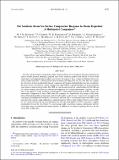The Southern Ocean Sea Surface Temperature Response to Ozone Depletion: A Multimodel Comparison
Author(s)
Seviour, W. J. M.; Codron, F.; Doddridge, Edward W.; Ferreira, D.; Gnanadesikan, A.; Kelley, M.; Kostov, Y.; Marshall, John; Polvani, L. M.; Thomas, J. L.; Waugh, D. W.; ... Show more Show less
DownloadPublished version (1.525Mb)
Publisher Policy
Publisher Policy
Article is made available in accordance with the publisher's policy and may be subject to US copyright law. Please refer to the publisher's site for terms of use.
Terms of use
Metadata
Show full item recordAbstract
The effect of the Antarctic ozone hole extends downward from the stratosphere, with clear signatures in surface weather patterns including a positive trend in the southern annular mode (SAM). Several recent studies have used coupled climate models to investigate the impact of these changes on Southern Ocean sea surface temperature (SST), notably motivated by the observed cooling from the late 1970s. Here we examine the robustness of these model results through comparison of both previously published and new simulations. We focus on the calculation of climate response functions (CRFs), transient responses to an instantaneous step change in ozone concentrations. The CRF for most models consists of a rapid cooling of SST followed by a slower warming trend. However, intermodel comparison reveals large uncertainties, such that even the sign of the impact of ozone depletion on historical SST, when reconstructed from the CRF, remains unconstrained. Comparison of these CRFs with SST responses to a hypothetical step change in the SAM, inferred through lagged linear regression, shows broadly similar results. Causes of uncertainty are explored by examining relationships between model climatologies and their CRFs. The intermodel spread in CRFs can be reproduced by varying a single subgrid-scale mixing parameter within a single model. Antarctic sea ice CRFs are also calculated: these do not generally exhibit the two-time-scale behavior of SST, suggesting a complex relationship between the two. Finally, by constraining model climatology–response relationships with observational values, we conclude that ozone depletion is unlikely to have been the primary driver of the observed SST cooling trend. © 2019 American Meteorological Society.
Date issued
2019-07Department
Massachusetts Institute of Technology. Department of Earth, Atmospheric, and Planetary SciencesJournal
Journal of Climate
Publisher
American Meteorological Society
Citation
Seviour, W. J. M., et al. "The Southern Ocean Sea Surface Temperature Response to Ozone Depletion: A Multimodel Comparison." Journal of Climate 32,16 (August 2019): 5107-5121 © 2019 Author(s)
Version: Final published version
ISSN
1520-0442
0894-8755